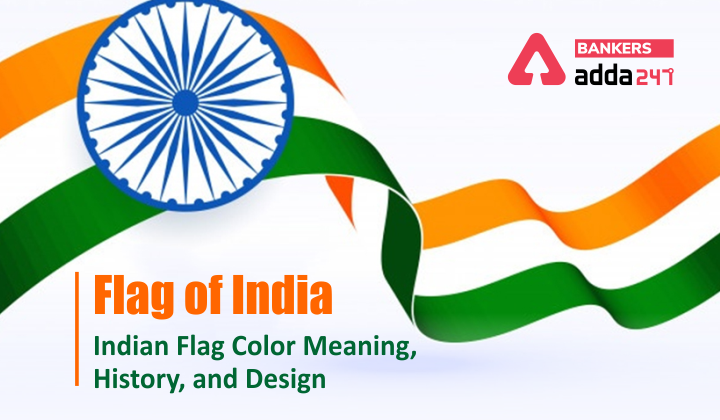Flag of India, Tricolour: The national flag represents the hopes and aspirations of the people of India. It is the symbol of our national pride. Every free nation of the world has its own flag. On 22nd July 1947, the national flag of India was adopted in its present form during the meeting of the constituent assembly. The tricolor became the official flag of India on the day on which India gets independence i.e. 15th August 1947. Today in this article, we are going to discuss all the necessary details about the flag of India, like its meaning, history, and design.
Flag of India Tricolour
Flag of India Tricolour: The rectangular tricolor flag consists of three equal segments, saffron on the uppermost, white in the middle, and green at the lowest. At the center of the white stripe is an Ashok Chakra is located in navy blue.
Flag of India is to be prepared from Khadi, hand-woven cotton or silk, following the manufacturing protocols laid out by the Bureau of Indian Standards (BIS). The Khadi Development and Village Industries Commission holds the right to manufacture the Indian National flag and as of 2009, the responsibility lies with the Karnataka Khadi Gramodyoga Samyukta Sangha.
Indian Flag Color Meaning
In the Indian National Flag, the top band is of Saffron color, which indicates the strength and courage of the country. Our leaders must be unique and away from material gains and dedicate themselves to their work The white band middle band indicates peace and truth with Dharma Chakra. The white color denotes, the path of truth to guide our conduct. The last band is green in color shows the fertility, growth, and auspiciousness of the land. The green color shows our relation to plant life, on which all other life depends. Ashok Chakra at the center of the white strip denotes the law of dharma.
Flag of India, Tricolour: Design
The National Flag of India is in rectangular in shape. The ratio of the length to the height (width) of the Flag is 3:2. The National Flag is a tri-colour panel made up of three rectangular panels or sub-panels of equal widths. The colour of the top panel shall be Indian saffron (Kesari) and that of the bottom panel is Green. The middle panel is white, bearing at its centre the design of Ashoka Chakra in navy blue colour with 24 equally spaced spokes. The Ashoka Chakra is preferably screen-printed.
Flag of India, Tricolour: History
The National Flag of India called the tricolour, it is a horizontal rectangular tricolour flag of India. It was adopted in its present form during a meeting of the constituent assembly. held on 22nd July 1947, and it become the official flag of India on 15th August 1947. The design of the flag of India that was first presented in 1921 to Mahatma Gandhi, leader of the all-India congress, was created by Pingali Venkayya. However, the Indian National Flag went through many changes before arriving at what it is today.
Flag of India, Tricolour: Code
The Indian National Flag represents the hopes and aspirations of the people of India. The ratio of the length to the height (width) of the Flag is 3:2. It is a symbol of our national pride. On 26th January 2002, the Indian flag code was modified and after several years of independence, the citizens of India were finally allowed to hoist the Indian flag over their offices, homes, factories, etc. Here we have provided the Code of National Flag in the given table.
| Flag Size | Dimensions in mv | |
| 6300 | X | 4200 |
| 3600 | X | 2400 |
| 2700 | X | 1800 |
| 1800 | X | 1200 |
| 1350 | X | 900 |
| 900 | X | 600 |
| 450 | X | 300 |
| 225 | X | 150 |
| 150 | X | 100 |
Latest Govt Jobs Notifications
| PNB Recruitment 2022 |
IBPS PO Notification 2022 |
| LIC HFL Recruitment 2022 | Shipping Corporation of India Recruitment 2022 |
| CBHFL Recruitment 2022 Notification | PMC Recruitment 2022 |
FAQs: Flag of India, Tricolour
Q1. What does the 3 colors of the flag mean?
Ans. Top band is of Saffron color, which indicates the strength and courage of the country. white band middle band indicates peace and truth with Dharma Chakra. The green color shows our relation to plant life, on which all other life depends. Ashok Chakra at the center of the white strip denotes the law of dharma.
Q2. What is the history of the Flag of India?
Ans. Candidates can check the history of the flag of India in the given above article.
Q3. Why Ashoka Chakra is blue?
Ans. Blue color represents the sky, the ocean and the universal truth.
Current Affairs
| Current Affairs April 2022 | |




 GA Capsule for SBI Clerk Mains 2025, Dow...
GA Capsule for SBI Clerk Mains 2025, Dow...
 The Hindu Review October 2022: Download ...
The Hindu Review October 2022: Download ...
 Bank Exams 2025, Check Full List of Upco...
Bank Exams 2025, Check Full List of Upco...


